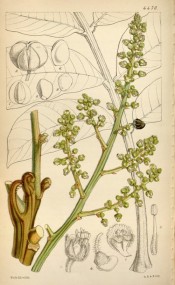Diploglottis australis (G.Don) Radlkf.
Half hardy, medium-sized to large tree, its young leaves and branches covered with rusty down, with pinnate leaves, to 60cm or more long, composed of up to 12 elliptic leaves, to 30cm long, and large, panicles of many small flowers. [RHSD, Hortus, FNSW, Beadle].
Horticultural & Botanical History
Introduced to Britain in 1823. [PD]. ‘The attention of most visitors to the great stove of the Royal Gardens is attracted to a lofty growing shrub or tree among the Palms, exceeding many of them in height, with large pinnated leaves, with the young branches especially clothed with ferruginous down, and labelled Stadtmannia australis of Allan Cunningham: it flowers in the spring, and is succeeded by large clusters of orange-coloured downy fruit, which split open while yet attached to the plant, and exhibit the bright orange pulpy arillus containing the seed. This is the plant of which we here represent as much as our ordinary-sized plate will allow. It is a native of New Holland, on the north-east coast near the tropics, and was discovered by Allan Cunningham, who speaks of it in his notes before me as “a tree 30-40 feet high, found in dark woods at Five Islands district, and on the banks of Hastings River, at Port Macquarrie and Brisbane in Moreton Bay.” I have specimens likewise, gathered at West Macquarrie by Mr. James Backhouse. Stadtmannia of Lamarck has now merged into Cupania; and other species being found in Australia I have named the species after its lamented discoverer. It is a noble plant with handsome foliage and fruit, but rather insignficant flowers, and of too lofty growth for ordinary cultivation. [ ] A large tree of robust growth, in its native forests conspicuous above the other trees, the bark having an iron-like appearance. It is a native of the east coast of New Holland, about 310 south latitude, and therefore not adapted for out-door cultivation in this country. The plant from which the drawing was made was introduced in 1825, and for a number of years was kept in the green-house, and shifted as it increased in size into a larger pot, and ultimately into a plant-tub, in which it out-grew our green-house accommodation; this caused it to be removed into the tropical Palm-house, where the stimulus of a warmer atmosphere induced it to flower for the first time during the present summer, and having perfected its seeds it has enabled us to obtain a stock of young plants; for on account of its little tendency to throw out lateral branches we have not had the opportunity of increasing it by cuttings. It has therefore been considered a rare plant in this country, and being best adapted for growing in lofty houses, it can only be valued by a few; but as it is of remarkable and striking habit, and on that account worthy of being admired, it may be kept in a small state for a number of years; like a second plant in this garden of the same age, which is not half the size of the first.’ [BM t.4470/1849]. Don.
History at Camden Park
Published in the 1850 and 1857 catalogues [T.944/1850]. Macarthur sent 1 plant, collected in the Illawarra, to Loddiges’ Nursery in 1846. [MP A2933-1, p.147].
Notes
Published Mar 19, 2009 - 04:04 PM | Last updated Mar 22, 2010 - 02:19 PM
| Family | Sapindaceae |
|---|---|
| Category | |
| Region of origin | Eastern Australia |
| Synonyms |
|
| Common Name | Native tamarind |
| Name in the Camden Park Record | Stadmannia Australis |
| Confidence level | high |
